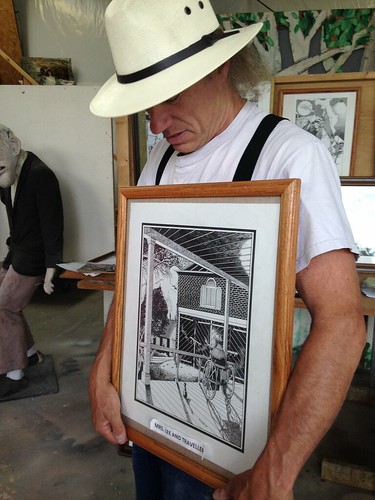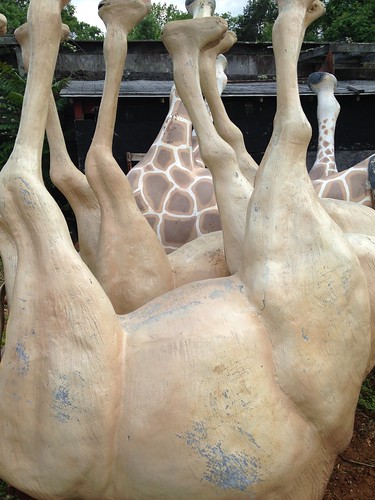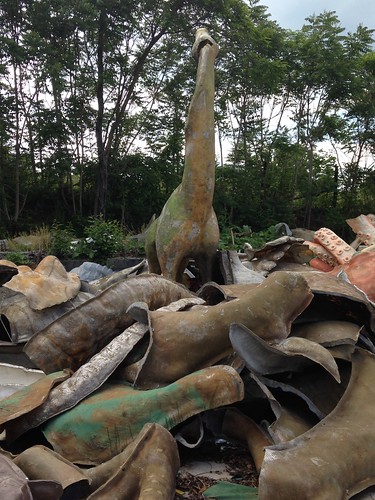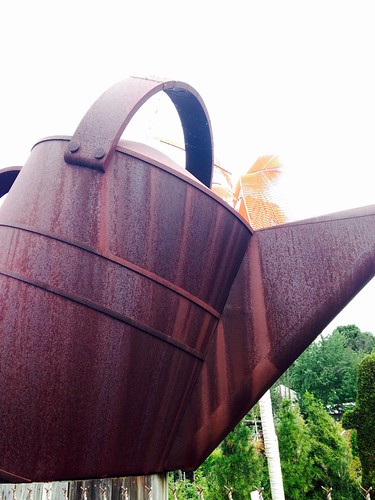
Volume XII, Issue XXIIIa
Meeting Merlin
A Visit to Enchanted Castle Studios
Sculptor Mark Cline of Natural Bridge had a great fan in his friend Jamie Jordan of Waynesboro. He had an unusual request for the sculptor. He knew he was dying and asked his friend to create a lasting impression of his face and to “use it appropriately.” When Mr. Jordan died just short of his sixtieth birthday, Cline made a casting of his friend’s face two days later at the funeral home and used it to create ‘Merlin.’
Although Natural Bridge’s recent inclusion in the Virginia State Park System meant that a number of Mark Cline creations had to be moved away, ‘Merlin’ will be part of a reconstructed ‘Foamhenge,’ a replica of Stonehenge that he created for Natural Bridge some time back. ‘Foamhenge’ will rise again in Centerville, Virginia. And although Natural Bridge’s ‘Monster Museum’ fell victim to runaway forest fires several years ago, Cline is still busy with orders for museum dinosaurs for parks across the country. His ‘Alternative History’ Dinosaur Land Park revolves around the story of explosives in the War between the States causing the great lizards to awaken. Think about it. Some of the Valley’s limestone caves have yet to be fully explored!
It’s a great story and Cline is producing graphic novels to tell it. He shows us some proofs. Then he shows us a project he is really engaged in… a sculpture of Lexington, Virginia’s most famous resident, Robert E. Lee. He acknowledges that some will find this controversial, but he is well versed in the history of the man himself and portrays him as a smiling genial man, unlike the photographs that survive and appear to show a stern and distinguished Lee. Cline wants to delve into the complex story of Robert E. Lee, a military commander respected by all, who was a Christian and a man of family. Gene Smith writes of him: “Robert E. Lee was a wonderful father to his young children. He taught them to ride, bought sleds and skates, had them learn to swim, competed in their jumping contests, was intensely involved in their studies. Telling lively and entertaining stories—he liked to be tickled and would say, “No tickling, no stories”—and showing how step-by-step solutions could be found for Schoolbook problems, he was always cheery and with a bright smile that, Robert Jr. remembered, characterized him for his boys and girls.” In 1861, president-elect Lincoln offered Lee the command of the United States Forces but he made the difficult decision instead to resign his commission saying: ‘I cannot raise my hand against my birthplace, my home, my children.’
Lee was respected by leaders both Northern and Southern. He initially believed that his strong response would lead to a speedy resolution of the conflict. He assumed command of the Army of Northern Virginia to that end but the war would go on for four bloody years. Lee himself was deeply troubled by that. When he surrendered to Ulysses S. Grant at Appomattox Courthouse in Virginia, he arrived freshly dressed and ready to promote healing. Like so many who fought in that terrible war, Lee was penniless. He had lost his wife’s family’s estates on the shores of the Potomac, now the site of Arlington National Cemetery. He was offered lucrative positions, even $50,000 for the use of his name, but he turned that down saying: ‘Sirs, my name is the heritage of my parents. It is all I have and it is not for sale.’
Instead, he accepted the presidency of troubled Washington College in Lexington, Virginia. He felt that this was the place he could best promote the healing of the country by investing himself in the lives and education of young people. His home there included a stable for his beloved horse Traveler. Lee died 9:30 AM on the morning of October 12, 1870, at his office at Washington College. His last words were ‘Strike the tent.’ He was 63 years of age. Today the school is named Washington and Lee and is a major American University.
Lee worked tirelessly to facilitate reconciliation. The man so many are quick to revile actually said “So far from engaging in a war to perpetuate slavery, I am rejoiced that slavery is abolished. I believe it will be greatly for the interests of the South.” Mark Cline would give us that more complete picture of an American icon.
And so, underlying his ‘alternative history’ with dinosaurs and soldiers, there is a deep sense of the value of pure history and its honest telling.

The face of Merlin.

Mrs. Lee and Traveler. Lee's widow outlived the General and his beloved horse, but always left the stall door open for his return.

Castings for Giraffes and Camels.

A 'Boneyard' of Monster Molds.
Willie Ferguson
A Legacy that Lives Large
Born in Edinburgh, Scotland to a Scottish father and a Sicilian mother, Willie Ferguson came to America at the age of seven. His father was a physician at Western State Hospital and the family lived on the grounds. His father wanted him to go to college but Willie chose instead to go to welding school in Richmond. He founded Ferguson Metal Fabrication and built that into a thriving business. Still, Ferguson had an artistic impulse and created an impressive body of work including Staunton's Giant Watering Can, Ballet Slippers and a Hiking Boot, not to mention a companion Flower Pot for his Watering Can. Ten of his works are listed in the Inventory of American Sculpture as part of the Smithsonian's "Save Outdoor Sculpture!" program. He ran the shop with one employee, Jim Chestnut, who was the son of a blacksmith and makes medieval armor in his spare time. The two men built the enormous sculptures often without blueprints.



Willie Ferguson's works in Staunton have 'twins' at "Holly, Woods and Vines," A garden center in Mt. Vernon, Virginia. Photos by Bob Kirchman.
